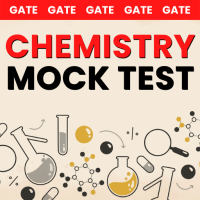Chemistry Exam > Chemistry Questions > With respect to hyper valence theory, which w...
Start Learning for Free
With respect to hyper valence theory, which will have multicenter bonding:
- a)B2H6
- b)CH6++
- c)SF4
- d)All are correct
Correct answer is option 'A'. Can you explain this answer?
Verified Answer
With respect to hyper valence theory, which will have multicenter bond...
Multicenter bonding is typically associated with compounds that exhibit bonding that cannot be explained by conventional two-center two-electron bonds. This often involves compounds with electron-deficient atoms or those that form hypervalent bonds.
Let's evaluate the options:
1. B2H6: Diborane (B2H6) is a classic example of a molecule with multicenter bonding. It has two bridging hydrogen atoms that are involved in three-center two-electron bonds, connecting two boron atoms. This is a well-known case of multicenter bonding.
2. CH6++: This is not a standard compound and seems hypothetical. Such a molecule would be highly unstable and could theoretically involve multicenter bonding, but it's not a commonly recognized species.
3. SF4: Sulfur tetrafluoride (SF4) is hypervalent and has 10 electrons around sulfur, but it does not involve multicenter bonding. The bonding in SF4 can be explained using standard two-center bonds.
2. CH6++: This is not a standard compound and seems hypothetical. Such a molecule would be highly unstable and could theoretically involve multicenter bonding, but it's not a commonly recognized species.
3. SF4: Sulfur tetrafluoride (SF4) is hypervalent and has 10 electrons around sulfur, but it does not involve multicenter bonding. The bonding in SF4 can be explained using standard two-center bonds.
Given that B2H6 clearly has multicenter bonding and the other options are either incorrect or ambiguous:
Correct Answer: 1. B2H6
Most Upvoted Answer
With respect to hyper valence theory, which will have multicenter bond...
Hyper Valence Theory and Multicenter Bonding:
Hyper Valence Theory is a concept that describes the formation of molecules that have more than eight electrons in their outermost shell. In such molecules, the central atom can form bonds with more than four atoms or groups.
Multicenter Bonding is a type of chemical bonding in which more than two atoms participate in the formation of a bond. In other words, it involves the sharing of electrons between three or more atoms.
Answer Explanation:
Out of the given options, only SF4 has multicenter bonding. Let's understand why SF4 has multicenter bonding:
1. Molecular Geometry: The molecular geometry of SF4 is trigonal bipyramidal. The central atom (Sulfur) is surrounded by four Fluorine atoms and one lone pair of electrons.
2. Hybridization: The Sulfur atom in SF4 undergoes sp3d hybridization to form five hybrid orbitals. These hybrid orbitals participate in the formation of bonds with the surrounding Fluorine atoms.
3. Bonding: In SF4, the four Fluorine atoms form a single bond with the central Sulfur atom. However, each Fluorine atom shares its electron with two hybrid orbitals of the Sulfur atom. Thus, the bond in SF4 involves three atoms (one Sulfur and two Fluorine atoms) and two electrons.
4. Multicenter Bonding: As mentioned earlier, multicenter bonding involves the sharing of electrons between three or more atoms. In SF4, the bond formation involves three atoms (one Sulfur and two Fluorine atoms) and two electrons. Hence, SF4 has multicenter bonding.
Conclusion:
From the above explanation, it is clear that only SF4 has multicenter bonding among the given options. Therefore, the correct answer is option 'A'.
Hyper Valence Theory is a concept that describes the formation of molecules that have more than eight electrons in their outermost shell. In such molecules, the central atom can form bonds with more than four atoms or groups.
Multicenter Bonding is a type of chemical bonding in which more than two atoms participate in the formation of a bond. In other words, it involves the sharing of electrons between three or more atoms.
Answer Explanation:
Out of the given options, only SF4 has multicenter bonding. Let's understand why SF4 has multicenter bonding:
1. Molecular Geometry: The molecular geometry of SF4 is trigonal bipyramidal. The central atom (Sulfur) is surrounded by four Fluorine atoms and one lone pair of electrons.
2. Hybridization: The Sulfur atom in SF4 undergoes sp3d hybridization to form five hybrid orbitals. These hybrid orbitals participate in the formation of bonds with the surrounding Fluorine atoms.
3. Bonding: In SF4, the four Fluorine atoms form a single bond with the central Sulfur atom. However, each Fluorine atom shares its electron with two hybrid orbitals of the Sulfur atom. Thus, the bond in SF4 involves three atoms (one Sulfur and two Fluorine atoms) and two electrons.
4. Multicenter Bonding: As mentioned earlier, multicenter bonding involves the sharing of electrons between three or more atoms. In SF4, the bond formation involves three atoms (one Sulfur and two Fluorine atoms) and two electrons. Hence, SF4 has multicenter bonding.
Conclusion:
From the above explanation, it is clear that only SF4 has multicenter bonding among the given options. Therefore, the correct answer is option 'A'.
Free Test
FREE
| Start Free Test |
Community Answer
With respect to hyper valence theory, which will have multicenter bond...
Here C should be ans as it is only which is hypervalent compound, while B2H6 electron deficient

|
Explore Courses for Chemistry exam
|

|
Question Description
With respect to hyper valence theory, which will have multicenter bonding:a)B2H6b)CH6++c)SF4d)All are correctCorrect answer is option 'A'. Can you explain this answer? for Chemistry 2025 is part of Chemistry preparation. The Question and answers have been prepared according to the Chemistry exam syllabus. Information about With respect to hyper valence theory, which will have multicenter bonding:a)B2H6b)CH6++c)SF4d)All are correctCorrect answer is option 'A'. Can you explain this answer? covers all topics & solutions for Chemistry 2025 Exam. Find important definitions, questions, meanings, examples, exercises and tests below for With respect to hyper valence theory, which will have multicenter bonding:a)B2H6b)CH6++c)SF4d)All are correctCorrect answer is option 'A'. Can you explain this answer?.
With respect to hyper valence theory, which will have multicenter bonding:a)B2H6b)CH6++c)SF4d)All are correctCorrect answer is option 'A'. Can you explain this answer? for Chemistry 2025 is part of Chemistry preparation. The Question and answers have been prepared according to the Chemistry exam syllabus. Information about With respect to hyper valence theory, which will have multicenter bonding:a)B2H6b)CH6++c)SF4d)All are correctCorrect answer is option 'A'. Can you explain this answer? covers all topics & solutions for Chemistry 2025 Exam. Find important definitions, questions, meanings, examples, exercises and tests below for With respect to hyper valence theory, which will have multicenter bonding:a)B2H6b)CH6++c)SF4d)All are correctCorrect answer is option 'A'. Can you explain this answer?.
Solutions for With respect to hyper valence theory, which will have multicenter bonding:a)B2H6b)CH6++c)SF4d)All are correctCorrect answer is option 'A'. Can you explain this answer? in English & in Hindi are available as part of our courses for Chemistry.
Download more important topics, notes, lectures and mock test series for Chemistry Exam by signing up for free.
Here you can find the meaning of With respect to hyper valence theory, which will have multicenter bonding:a)B2H6b)CH6++c)SF4d)All are correctCorrect answer is option 'A'. Can you explain this answer? defined & explained in the simplest way possible. Besides giving the explanation of
With respect to hyper valence theory, which will have multicenter bonding:a)B2H6b)CH6++c)SF4d)All are correctCorrect answer is option 'A'. Can you explain this answer?, a detailed solution for With respect to hyper valence theory, which will have multicenter bonding:a)B2H6b)CH6++c)SF4d)All are correctCorrect answer is option 'A'. Can you explain this answer? has been provided alongside types of With respect to hyper valence theory, which will have multicenter bonding:a)B2H6b)CH6++c)SF4d)All are correctCorrect answer is option 'A'. Can you explain this answer? theory, EduRev gives you an
ample number of questions to practice With respect to hyper valence theory, which will have multicenter bonding:a)B2H6b)CH6++c)SF4d)All are correctCorrect answer is option 'A'. Can you explain this answer? tests, examples and also practice Chemistry tests.

|
Explore Courses for Chemistry exam
|

|
Signup for Free!
Signup to see your scores go up within 7 days! Learn & Practice with 1000+ FREE Notes, Videos & Tests.
























